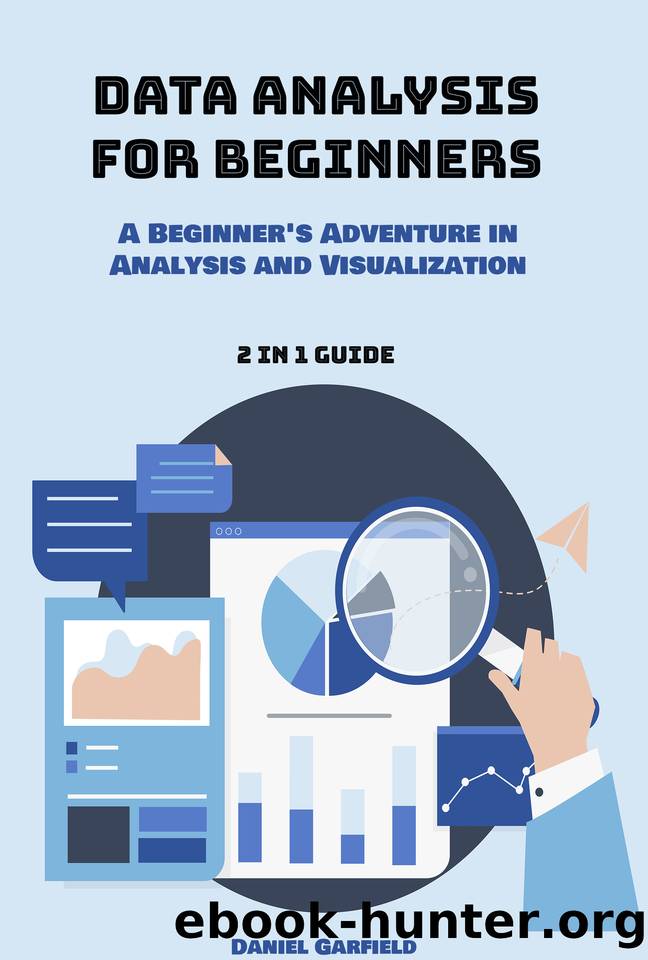Data Analysis for Beginners: 2 in 1 Guide: A Beginner's Adventure in Analysis and Visualization by Garfield Daniel

Author:Garfield, Daniel
Language: eng
Format: epub
Published: 2023-09-27T00:00:00+00:00
Visual encodings refer to the visual elements used to represent the underlying data accurately and efficiently. By carefully selecting the appropriate visual encodings, we can convey the relationships and patterns within the data in a way that is easy to understand and interpret.
The first consideration when choosing visual encodings is the type of data being visualized. Different types of data, such as numerical, categorical, or temporal, require different visual representations to effectively communicate their characteristics. Numerical data, for example, involves quantities and magnitudes, and is often best represented using visual elements such as bars or dots. Categorical data, on the other hand, involves discrete categories or groups, and can be effectively represented using visual elements such as bars, pie charts, or stacked columns. Temporal data, which involves time-related information, can be represented using line charts or area charts to track trends and changes over time.
Once the type of data is determined, it is important to choose visual elements that accurately represent the relationships and patterns within the data. Bar charts, for instance, are commonly used to compare quantities or values across different categories. They provide a straightforward and intuitive representation that allows for easy comparisons. Line charts, on the other hand, are ideal for tracking trends and changes over time. They effectively show the progression of data points and highlight patterns and fluctuations. Maps are often used to represent spatial distributions, allowing for the visualization of data across geographical locations.
In addition to these examples, there are various other visual encodings available, such as scatter plots, heat maps, area charts, and histograms, among others. Each encoding has its own strengths and is suitable for different types of data and analytical purposes. The key is to select the encoding that best aligns with the specific characteristics and objectives of the data being visualized.
Furthermore, it is important to consider the visual perception and cognitive abilities of the audience when choosing visual encodings. Certain visual elements may be more easily interpreted and understood by individuals based on their cultural background, prior knowledge, or visual acuity. Taking these factors into account helps ensure that the chosen encodings are accessible to the intended audience and facilitate their understanding of the data.
In summary, choosing the right visual encodings is essential for creating effective data visualizations. By considering the type of data being visualized, such as numerical, categorical, or temporal, and selecting appropriate visual elements that accurately represent the relationships and patterns within the data, we can create visualizations that are both accurate and easily interpretable. Understanding the strengths and limitations of different visual encodings and considering the audience's perceptual and cognitive abilities further enhances the effectiveness of the visualizations.
Use Color with Intention: Color can enhance the visual appeal and convey additional information in a visualization. Use color purposefully to highlight important elements or to differentiate categories. Ensure that color choices are accessible, considering factors like color blindness and contrast. Use a limited color palette and avoid using color for purely decorative purposes.
Download
This site does not store any files on its server. We only index and link to content provided by other sites. Please contact the content providers to delete copyright contents if any and email us, we'll remove relevant links or contents immediately.
What's Done in Darkness by Kayla Perrin(26800)
The Ultimate Python Exercise Book: 700 Practical Exercises for Beginners with Quiz Questions by Copy(20664)
De Souza H. Master the Age of Artificial Intelligences. The Basic Guide...2024 by Unknown(20442)
D:\Jan\FTP\HOL\Work\Alien Breed - Tower Assault CD32 Alien Breed II - The Horror Continues Manual 1.jpg by PDFCreator(20439)
The Fifty Shades Trilogy & Grey by E L James(19302)
Shot Through the Heart: DI Grace Fisher 2 by Isabelle Grey(19258)
Shot Through the Heart by Mercy Celeste(19125)
Wolf & Parchment: New Theory Spice & Wolf, Vol. 10 by Isuna Hasekura and Jyuu Ayakura(17291)
Python GUI Applications using PyQt5 : The hands-on guide to build apps with Python by Verdugo Leire(17225)
Peren F. Statistics for Business and Economics...Essential Formulas 3ed 2025 by Unknown(17071)
Wolf & Parchment: New Theory Spice & Wolf, Vol. 03 by Isuna Hasekura and Jyuu Ayakura & Jyuu Ayakura(16995)
Wolf & Parchment: New Theory Spice & Wolf, Vol. 01 by Isuna Hasekura and Jyuu Ayakura & Jyuu Ayakura(16611)
The Subtle Art of Not Giving a F*ck by Mark Manson(14609)
The 3rd Cycle of the Betrayed Series Collection: Extremely Controversial Historical Thrillers (Betrayed Series Boxed set) by McCray Carolyn(14305)
Stepbrother Stories 2 - 21 Taboo Story Collection (Brother Sister Stepbrother Stepsister Taboo Pseudo Incest Family Virgin Creampie Pregnant Forced Pregnancy Breeding) by Roxi Harding(13965)
Scorched Earth by Nick Kyme(12962)
Drei Generationen auf dem Jakobsweg by Stein Pia(11143)
Suna by Ziefle Pia(11065)
Scythe by Neal Shusterman(10553)
